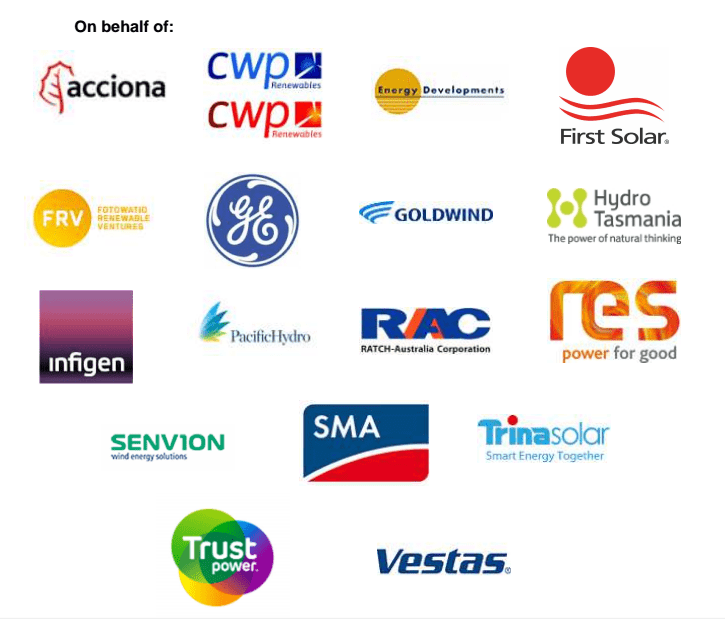A group of Australia’s leading clean energy investors have sent an open letter to state and federal members of parliament calling on the federal government to leave the Renewable Energy Target (RET) unchanged, and warning of the risk to billions of investment dollars – and a rise in electricity prices – if it is wound back or diluted.
The letter came as Dick Warburton, the head of the RET Review Panel, signalled that changes would be made to the target and expressed frustration that Clive Palmer would block any changes in the Senate.
The letter, written by the Clean Energy Council’s acting CEO Kane Thornton and co-signed by 17 major renewable energy companies – including First Solar, GE, HydroTasmania, Infigen Energy, Trina Solar and Vestas – was released today, ahead of the RET Review panel report, which is scheduled to be delivered sometime in the next two weeks.
“Our companies have made their investments in renewable energy projects on the basis of the 41,000GWh target continuing to operate as legislated out to 2030,” the letter says. “It is this fixed GWh target, rather than an ever-changing percentage based on a forecast, that has underpinned over $10 billion worth of investment to date.
“The 41,000GWh target, as currently legislated, will deliver the revenue necessary to recover the investments we have made. If the 41,000GWh target is reduced, or moved out past 2020, existing wind farms, bagasse plants, hydropower and large-scale facilities will suffer financial distress and the potential for financial failure.”
The Abbott government-mandated RET Review, headed up by self-proclaimed climate scepticWarburton, is widely expected to reduce the minimum amount of Australia’s electricity required to be produced from clean energy sources such as wind and solar, most likely to around 25,000GWh.
Bob Baldwin, the assistant minister for Industry, told the Clean Energy Week meeting in Sydney that Australia is “open for business”. In fact, he said it at least three times, but the industry points out that uncertainty over the RET has crippled investment for more than 18 months.
Opposition climate spokesman Mark Butler has said Australia was effectively closed for business in terms of renewables. Douglas Smith, the Australian had for Chinese solar giant Trina Solar, warned that his “bosses in China” were reassessing their aspirations for growth in Australia. “I can’t under-emphasise that point,” he said.
Warburton, who is also chairman of Westfield Retail Trust and a former Reserve Bank of Australia board member, recently said that his review panel was close to finishing its report.
He also expressed his concern that recent “crazy politics” in the Senate, such as the vetoing of major budget items by the Palmer United Party and others on the cross benches, did not augur well for changes to the RET.
“It would be disappointing, it would be frustrating, but that seems to be Clive Palmer,” Warburton told The Australian Financial Review.
Palmer, who has been shown to have a rather fickle view on climate and clean energy policy issues, has previously declared his commitment to keeping the 41,000 gigawatt hour target for renewable energy, saying the Abbott government could only lower the target if it wins a mandate at the next election.
Miles George, whose company Infigen Energy is Australia’s largest listed renewables group (and a signatory of the letter), has warned separately that without a long-term commitment to the RET, the sector was at risk.
“Hopefully the government and the parliament more broadly would accept that you can’t leave the industry in limbo with legislative uncertainty for another two years. The industry would pretty much collapse if that happened,” George said.
“Regulatory certainty is what we need. You can’t make a 20-year investment on the back of legislation that might change every two years.”
As the CEC open letter points out, Australia’s original Renewable Energy Target policy was originally introduced by the Howard government in 2001, and has since enjoyed mostly bipartisan support, having been expanded in 2009 and refined in 2010 to deliver 41,000GWh from large-scale sources by 2020 and at least 20 per cent renewable energy by that time.
According to energy market analysis, Thornton notes that the target, if left to operate as legislated, would deliver another $14.5 billion in investment in large-scale renewable energy infrastructure in Australia by 2020.
“Even better news is that Australia’s RET can actually lead to lower power prices in the long run,” the letter says. “The preliminary modelling undertaken for the RET Review panel by ACIL Allen Consulting found that household power bills will be on average more than $550 million more expensive per year beyond 2020 if the RET was removed. This is because renewable energy is playing an important role in reducing Australia’s reliance on increasingly expensive gas.”
Read the full text of the letter below.








